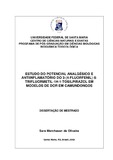| dc.creator | Oliveira, Sara Marchesan de | |
| dc.date.accessioned | 2017-05-02 | |
| dc.date.available | 2017-05-02 | |
| dc.date.issued | 2009-12-18 | |
| dc.identifier.citation | OLIVEIRA, Sara Marchesan de. Study of the analgesic and antiinflammatory potential of 3-(4-fluorophenyl)-5-trifluoromethyl-1h-1-tosylpyrazole in pain models in mice. 2009. 60 f. Dissertação (Mestrado em Bioquímica) - Universidade Federal de Santa Maria, Santa Maria, 2009. | por |
| dc.identifier.uri | http://repositorio.ufsm.br/handle/1/11114 | |
| dc.description.abstract | Pain is the most common complaint in the medical field and the identification of compounds that can effectively treat painful states without induction of side-effects remains a major challenge in biomedical research. The aim of the present study was to investigate the antinociceptive effect of a novel compound, 3-(4-fluorophenyl)-5-trifluoromethyl-1H-1-tosylpyrazole (compound A) in several models of pain in mice and compare with those produced by the known trifluoromethyl-containing pyrazole compound celecoxib. Compound A or celecoxib were administrated by oral (78 780 μmol/kg), intrathecal (9 22.5 nmol/site) or intracerebroventricular (9 22.5 nmol/site) routes. Oral administration of either compound A or celecoxib abolished the mechanical allodynia, but not the oedema caused by intraplantar injection of carrageenan. Similarly, compound A reduced the overt nociception, but not the oedema, produced by bradykinin or capsaicin. However, compound A (500 μmol/kg, orally) did not alter nociception nor oedema caused by intraplantar injection of prostaglandin E2 or glutamate, whereas celecoxib reduced only the nociception induced by the former. Moreover, oral and intrathecal administration of compound A or celecoxib also reduced the nociception induced by acetic acid. However, only celecoxib reduced the acetic acid-induced nociception when it was injected by the intracerebroventricular route. Finally, neither compound A nor celecoxib was able to produce antinociceptive effect in the tail-flick test or to alter the motor performance and the body temperature. Besides, compound A or celecoxib did not induce gastric lesion. Thus, compound A seems to be an interesting prototype for the development of novel analgesic drugs. | eng |
| dc.description.sponsorship | Coordenação de Aperfeiçoamento de Pessoal de Nível Superior | |
| dc.format | application/pdf | por |
| dc.language | por | por |
| dc.publisher | Universidade Federal de Santa Maria | por |
| dc.rights | Acesso Aberto | por |
| dc.subject | Dor | por |
| dc.subject | Nocicepção | por |
| dc.subject | Inflamação | por |
| dc.subject | Edema | por |
| dc.subject | Pirazóis | por |
| dc.subject | Analgésicos | por |
| dc.subject | Pain | eng |
| dc.subject | Nociception | eng |
| dc.subject | Inflammation | eng |
| dc.subject | Edema | eng |
| dc.subject | Pyrazoles | eng |
| dc.subject | Analgesics | eng |
| dc.title | Estudo do potencial analgésico e antiinflamatório do 3-(4-fluorfenil)-5-trifluormetil-1h-1-tosilpirazol em modelos de dor em camundongos | por |
| dc.title.alternative | Study of the analgesic and antiinflammatory potential of 3-(4-fluorophenyl)-5-trifluoromethyl-1h-1-tosylpyrazole in pain models in mice | eng |
| dc.type | Dissertação | por |
| dc.description.resumo | A dor é uma das maiores queixas na área médica e a identificação de compostos que possam tratar efetivamente os estados dolorosos, sem induzir efeitos colaterais, permanece um grande desafio na pesquisa biomédica. O objetivo do presente estudo foi investigar o efeito antinociceptivo de um novo composto 3-(4-fluorfenil)-5-trifluormetil-1H-1-tosilpirazol (composto A) em diferentes modelos de dor em camundongos e comparar os seus efeitos com aqueles produzidos por um pirazol contendo trifluormetil em sua estrutura, o celecoxibe. O composto A ou o celecoxibe foram administrados por via oral (78 780 μmol/kg), intratecal (9 22,5 nmol/sitio) ou intracerebroventricular (9 22,5 nmol/sitio). A administração oral do composto A ou do celecoxibe aboliram a alodínia mecânica, mas não o edema, causado pela injeção intraplantar de carragenina. Do mesmo modo, a administração do composto A reduziu a nocicepção, mas não o edema, produzido pela bradicinina ou capsaicina. Entretanto, o composto A administrado por via oral (500 μmol/kg) não alterou a nocicepção nem o edema causados pela injeção intraplantar de prostaglandina E2 (PGE2) ou glutamato. Já o celecoxibe, reduziu somente a nocicepção induzida pela PGE2. Além disso, a administração oral ou intratecal do composto A ou celecoxibe também reduziu a nocicepção induzida por ácido acético. Quando administrados por via intracerebroventricular, somente o celecoxibe foi capaz de reduzir a nocicepção induzida por ácido acético. Finalmente, o composto A ou o celecoxibe não alteraram a nocicepção térmica aguda, a performance motora ou a temperatura corporal dos animais, nem produziram lesões gástricas quando administrados por via oral. Consequentemente, o composto A parece ser um interessante protótipo para o desenvolvimento de novas drogas analgésicas. | por |
| dc.contributor.advisor1 | Ferreira, Juliano | |
| dc.contributor.advisor1Lattes | http://buscatextual.cnpq.br/buscatextual/visualizacv.do?id=K4768702Y6 | por |
| dc.contributor.referee1 | Otuki, Michel Fleith | |
| dc.contributor.referee1Lattes | http://buscatextual.cnpq.br/buscatextual/visualizacv.do?id=K4765550U6 | por |
| dc.contributor.referee2 | Oliveira, Mauro Schneider | |
| dc.contributor.referee2Lattes | http://buscatextual.cnpq.br/buscatextual/visualizacv.do?id=K4705848A9 | por |
| dc.creator.Lattes | http://buscatextual.cnpq.br/buscatextual/visualizacv.do?id=K4268855J0 | por |
| dc.publisher.country | BR | por |
| dc.publisher.department | Bioquímica | por |
| dc.publisher.initials | UFSM | por |
| dc.publisher.program | Programa de Pós-Graduação em Ciências Biológicas: Bioquímica Toxicológica | por |
| dc.subject.cnpq | CNPQ::CIENCIAS BIOLOGICAS::BIOQUIMICA | por |


